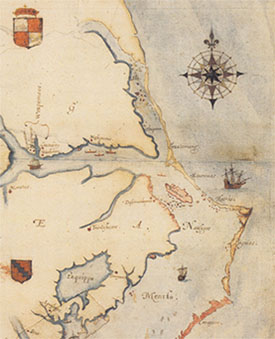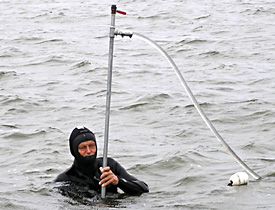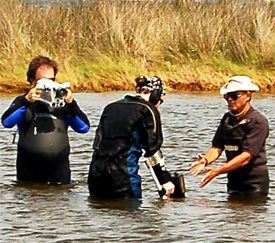
Institute for International Maritime Research, Inc:
Raleigh Colony Investigation
More than two decades before English colonists arrived at Jamestown, Virginia to establish the first permanent English settlement in North America, Sir Walter Raleigh organized several attempts to establish a colony on Roanoke Island, North Carolina. Encouraged by the explorations of Sir Humphrey Gilbert, Raleigh obtained a charter for establishing a New World settlement south of Newfoundland. In April 1584, two ships under the command of Philip Amadas and Arthur Barlowe sailed for North America with the experienced Portuguese pilot Simon Ferdinando.

Map by John White. Virginea Pars. 1585.
The glowing report on exploration of what is today Roanoke Island led Raleigh and his associates to dispatch another expedition a year later. That expedition included the first settlers but they could not be adequately supplied and when Sir Francis Drake appeared off the coast in June the disgruntled settlers took the opportunity to abandon Roanoke Island and return to England. Although frustrated Raleigh and his company organized another expedition under the John White. That expedition arrived off Roanoke in July 1586. While the men, women and children of the 1586 expedition established housing and fortifications on Roanoke, John White returned to England to obtain and return with supplies. By the time he was able to return in 1590, the settlers had abandoned Roanoke Island leaving the word “CROATOAN” on a tree to suggest their whereabouts.

Volunteers Ralph Wilbanks and Darrell Taylor aboard Diversity.
The mystery of Sir Walter Raleigh’s “Lost Colony” remains unanswered. Not even the location of the settlement has been identified to date. However, the First Colony Foundation, Inc., of Durham, North Carolina and the Institute for International Maritime Research, Inc.(IIMR), of Washington, North Carolina have joined in a cooperative effort to locate and identify archaeological remains of the settlement, fortification and vessels associated with the colonists.

Dr. Gordon Watts uses a hydro probe
In addition to continuing efforts to identify terrestrial remains in the vicinity of the reconstructed fortification managed by the National Park Service, First Colony and IIMR are carrying out underwater archaeological investigations off Roanoke Island. The underwater investigations are based on data generated by magnetic and acoustic remote sensing. Targets identified using cesium vapor magnetometers and high-resolution side scan sonars are being systematically identified by archaeological divers and volunteers. Each target site is relocated using differential global positioning systems. Hydraulic probes and water induction dredges are used to expose cultural material generating the anomaly.

Randy video tapes Della locating targets using an underwater metal detector with Ray's help.
While target assessment activities carried out in October 2005 were frustrated by bad weather, additional remote sensing and target assessment activities are planned for September 2006. Both First Colony and I2MR are committed to pursuing archaeological investigations at Roanoke Island until the Raleigh Colony site can be identified.

Small sample of magnetometer contour map showing targets for investigation.
View the Next Lost Colony post.
Return to In The Field home page.




